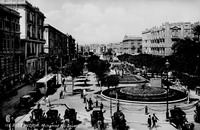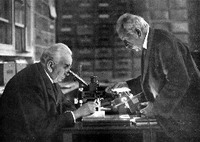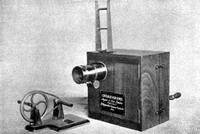Alexandria, Why?
I. Alexandria: Historical Background

Mohamed Ali Square
(Formerly Place des Consuls)

Lumiere Brothers

Lumière Brothers’ Cinematographe
The Egyptian cinema industry began in Alexandria. This is no coincidence, for Alexandria was a pioneer in many other areas. It had an atmosphere different from the rest of Egypt, which encouraged entrepreneurship and innovation and led to a boom in all major fields.
Historically, Alexandria was referred to as “Alexandrea Ad AEgyptum” – Alexandria next to Egypt. Since it was founded by Alexander the Great in 331 BCE to be an open city that crystallized his vision of Hellenizing the world, Alexandria has been a multi-ethnic, multi-cultural and multi-denominational city. In antiquity it was the capital of the classical world, and its Pharos and Library endure as universal symbols of enlightenment. In the modern world it remains fixed in human memory as the cosmopolitan city par excellence – a rich mosaic of diverse races, tongues and faiths – where tolerance and diversity made possible all kinds of cultural interaction and development.
Mohamed Ali (ruled 1805-1847), the founder of modern Egypt, paid especial attention to Alexandria. He realized that for Egypt to become a world power, it needed a strong navy, which was to be created in Alexandria. The city itself had to be prepared for this giant undertaking, and so its infrastructure was re-hauled and steps were taken to encourage experts to come, bringing with them modern technology, commerce and initiative. The Western Harbour for commercial shipping, previously closed to Christian ships, was now opened to them. Privileges were granted to foreigners such as consular protection under the system of Capitulations, the right to be tried in the Mixed Tribunals (1876), and a certain exemption from taxes and customs. The security and wealth the city offered contrasted with the wars, persecution and poverty rife in the Mediterranean, Europe and Asia, and acted as a magnet for all who sought refuge and asylum, or the possibility of a fortune.
As it was the principal point of entry into Egypt, it also became the place where most newcomers settled and thus where many of the commercial and cultural activities were conducted. The concept of nationhood was still a nascent one, and many of the countries surrounding Egypt, including Egypt itself, were part of the Ottoman Empire. The Egyptian nationality only appeared in 1929, and it was not until 1936 that the Montreux Convention abolished Capitulations and forced people to choose a nationality (thereby also hammering a nail in the coffin of Alexandrian cosmopolitanism). Because of this fluidity between borders and the fact that the citizens of those countries were all Ottoman subjects, “nationality” did not count for much. Mobility was easy, and harsh immigration laws did not exist to deny Ottoman subjects entry into the country. Once in Alexandria, the immigrant could affiliate himself to one of the foreign consular powers present in the city and acquire that nationality. It was not unusual for brothers of the same family to hold a different nationality. An Alexandrian of mixed origins, Eugenie Sinano Horwitz, writes in 1949 of her ancestors: “My grandfather, of Syrian origin, living in Egypt, with an Italian passport, was consul of Portugal. His brother was the Danish consul. I never discovered why those countries chose them or how they came into the family’s sphere of influence” (Awad and Hamouda 51). In the absence of a national identity, these foreigners, many of whom were born and died in Alexandria and had never seen their “native” country, owed allegiance to Alexandria. They became the citizens of a city: Alexandrian citizens. Eventually, the new arrivals organized themselves into communities according to their country of origin, so that the Greeks formed the Greek community (1843, the first established in Egypt, and also the largest), the Italians the Italian community, the Shawam (the Syrian-Lebanese) formed the Syrian community, and so on. The only community to be organized according to religion was the Jewish one, but it was organized along the same lines as the ethnic communities: it had its hospital, schools and welfare organizations. The healthy rivalry between the different communities as to which would build the most beautiful church or the largest hospital only led to the development and embellishment of the city. Undoubtedly foreigners lived in other parts of Egypt as well, but it was in Alexandria that there was the largest congregation of foreigners. In 1879 the foreigners in Alexandria made for 61% of the total foreign population of Egypt.
This incredible variety and fluidity did have a positive effect on all aspects of life in Alexandria, notably in the establishment of institutions that would guarantee the generation of wealth, the organization of urban growth, the creation and maintenance of services, and the encouragement of cultural activities. Trade was the lifeblood of the city, as 94% of Egypt’s exports left through Alexandria. The traditional export of onions was replaced by the export of the new white gold: cotton. The Alexandria Cotton Exchange (1871) soon rivalled that of New York and Liverpool and brought fabulous wealth to the cotton merchants. The other institutions were more geared towards regulating life in the city and many of them were the first of their kind in Egypt. For instance, due to the outbreak of epidemics of cholera and the plague in Alexandria, many of which were brought in by the sailors, the Intendance Sanitaire, or Egyptian Board of Health was created by the combined efforts of the Khedive and the consuls of Britain, Austria, France, Russia and Tuscany. It was headed by the British Consul-General, and is one of the earliest attempts at health reform, carried out by the Government together with the foreign consuls. Another pioneering institution was the Commissione di Ornato, or Board of Works (1934). Like the Board of Health, it was the first of its kind in Egypt, and was also composed of foreign consuls and merchants. Its first president was Michael Tossizza, the Greek Consul-General, who was followed by the Italian architect Francesco Mancini. Its aim was to supervise the planning of the city and monitor construction and esthetic standards. Such collaboration between locals and foreigners is most evident in the creation of the Municipality of Alexandria, also the first of its kind in Egypt. It was established in 1890 and was composed of elected members who formed the leaders of the foreign communities and the leading merchants and cotton kings. This new institution gave Alexandria a certain degree of autonomy, since it represented most of the communities resident in Alexandria, including Egyptians, though not more than two were allowed to represent a foreign community. The Municipality was responsible for taxation, urban growth and major projects.
Perhaps the best example of shared space is the establishment of the first secular school in Egypt: the famous Victoria College, the alma mater of Michel Chalhoub (better known as Omar Sharif) and of Youssef Chahine, both of whom are originally from Lebanon. Established in 1901 by the British community in Alexandria to provide a liberal and secular education to the sons of Alexandria, it was soon attracting boys from over 22 communities and denominations. The greatest witness to the spirit of diversity and liberalism that Victoria College reflected and encouraged is the article written by an old boy in the school magazine The Victorian in 1930:
This is what every boy and what every old boy feels, that we all belong to the same race, that the only real and natural ties among men are the ties of human fellowship, without distinction of nationality, colour or creed. The great, the unique achievement of Victoria College, placed as it is in a cosmopolitan centre like Alexandria, is to have created for its boys an atmosphere so pure and healthy, so deeply and essentially human, that no germs of national or religious animosity can exist, far less thrive, in it.
It was not only in the creation of these institutions that Alexandria had become a pioneer. The flow of ideas and interaction between different ethnicities and denominations provided a spirit of liberty and freedom of thought. It was in Alexandria, in the Place des Consuls (later Place Mohamed Ali, and later still Manshieh Square) that the equestrian statue of Mohamed Ali was mounted: the first statue of a human figure to be set up in a public space in a Moslem country. And it was in this city that a cemetery for free thinkers was found, lying in the same area as the cemeteries of Moslems, Jews, Maronites, Anglicans, Copt Orthodox, Greek Orthodox, Armenian Orthodox, Syrian Catholics, Armenian Catholics and Latin Catholics.
And where institutions run by both foreigners and Egyptians provided progress and proper planning for the city, the cultural interaction between foreigners and Egyptians made certain things appear in Alexandria first before spreading to Cairo. Just as foreigners and foreign goods first arrived in Egypt through the port, so too did cultural innovation. The first private Arabic press was established in Alexandria by the Shawam (el Kawkab el Sharqi 1873), as were the first feminist papers (el Fatah 1882). The theatre had been non existent, as actors were considered little better than clowns and the stage was for the performance of puppet shows and shadow plays. When the Syrian troupes started arriving in Alexandria, encouraged by the opportunities it offered and the spirit of freedom and tolerance it enjoyed, people such as Adib Ishaq and Selim Naqash began performing in Alexandria, in the Zizinia Theatre in 1876. Thrilled by this new form of art, Alexandrians like Sayed Darwish, Bairam el Tonsi and Sheikh Salama Hegazi joined them to establish the Arabic lyrical theatre. And from the theatre, it was only one step to the cinema.
References
- Awad, Mohamed & Sahar Hamouda (eds). The Zoghebs: An Alexandrian Saga. Alexandria: Bibliotheca Alexandrina, 2005.
- Hamouda, Sahar. “El Iskandariyyah ‘assemat el zâkirah”. El moudoun el ‘arabiya el kozmopoulîtîya. Beirut, 2004.
- Hamouda, Sahar & Colin Clement (eds). Victoria College: A History Revealed. Cairo: AUC Press, 2002.
- Lumière Brothers’ Cinematographe.

